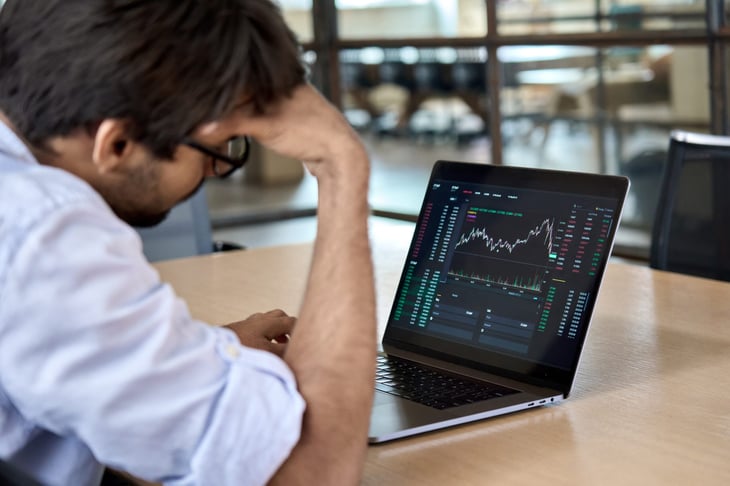
Editor's Note: This story originally appeared on The Penny Hoarder.
Cryptocurrency investors are reeling and wondering what comes next after a massive market shakeup sent the price of bitcoin plummeting to its lowest level in 17 months.
The pullback was triggered by the collapse of two of the largest cryptocurrencies — the stablecoin TerraUSD and its sister token Luna.
Terra’s value is meant to stay at $1. But it wasn’t backed by real-world assets. Instead, the two tokens were tied in value to one another like a seesaw. One token would be automatically created or destroyed based on the supply and demand of the other.
But why did investors sink so much money into these tokens?
A scheme known as the Anchor protocol promised crypto investors annual returns of nearly 20% in exchange for lending out their Terra holdings. With cryptocurrency markets relatively stagnant since December, the lure of 20% returns seemed too good to pass up.
But few Terra/Luna investors paused to realize they were stacking risk on top of risk on top of more risk.
New York Magazine described the system “as a perpetual wealth-creation machine, a way to always make money through the magic of code and financial engineering.”
The machine worked great — until it didn’t.
Terra’s algorithm eventually broke — there’s still some confusion and debate over why — and its value started nosediving May 8. As investors sold off UST, the supply of luna ballooned, causing its price to plummet. From there, UST and Luna locked arms in a death spiral race to the bottom.
By May 12, the stablecoin once pegged at $1 was trading for less than a penny.
The collapse of Terra and Luna erased some $45 billion in market capitalization in a week. Experts say that money is unlikely to return.
The fallout sent ripples across the entire crypto ecosystem, causing bitcoin and ethereum to hit lows not seen since December 2020.
By May 16, bitcoin traded at around $29,000 — more than a 50% decline in value from its all-time high of roughly $68,000 five months ago.
The UST-Luna fiasco highlights the danger of investing in unproven algorithmic stablecoins and leveraging money in the unregulated world of decentralized finance.
Many cryptocurrency investors are now wondering what comes next and how to safeguard their portfolios. After all, it’s not just cryptocurrency that’s suffering — the entire U.S. economy is sluggish. Inflation is high, interest rates are rising, stocks are down (the S&P 500 has lost over 16% of its value so far in 2022) and many experts are forecasting a recession in the next six to 12 months.
We sat down with five experts who offered insight into navigating these uncertain times — and the best ways to protect your portfolio from a future crypto crash.
1. Don’t Go All-In

If you’re investing in cryptocurrency, it needs to be part of a balanced portfolio that meets your goals. For most people, this means allocating no more than 5% of your portfolio to a risky investment like crypto.
Sometimes people only look at the upside when investing. They think “Wow, I could have made a lot of money if only I had invested in this or that.”
No one has perfect foresight. That’s why it’s so important to diversify with other assets.
— Robert Persichitte, a tax accountant and certified financial planner at Delagify Financial
2. Read the Fine Print

The lesson people should take away from the Terra/Luna crash is that you need to make sure you clearly understand the economic rationale of these projects before investing in them.
In the months and weeks ahead, cryptocurrencies will face the same challenge as other major asset classes — rising interest rates — which tend to negatively impact the value of risky investments.
Most investors are seeing a broad pullback in all their investments right now, including stocks. There’s not much investors can do in such situations except to keep their portfolios balanced and diversified.
— Erik Goodge, a certified financial planner and president of uVest Advisory Group
3. Be Safe, Be Secure

Employ best practices in diversity, securing your private keys and don’t over-leverage yourself. Know that while this is a setback, it’s a temporary one.
Eventually, trust will re-enter the market and you’ll get another shot.
— Chris Brooks, co-founder of Crypto Asset Recovery
4. Play the Long Game

When investing for the long-term, you understand that corrections are part of a normal market. That makes it easier to ride out the lows and wait for the eventual recovery.
One positive that can occur during a correction like this is a tax-loss harvesting opportunity: You can sell certain assets to capture losses and offset capital gains tax you may owe next year.
— Lance Elrod, a certified financial planner with Next Step Financial Transitions
5. Buy and Hold (on for Dear Life)

Possibly the most important thing for investors to remember is don’t panic. Cryptocurrency is a highly volatile investment and these types of price swings are to be expected.
The crash in crypto has reminded us why a long-term investment strategy is so important. The crypto community has even come up with the phrase HODL which means “hold on for dear life.”
The phrase reminds us that investing in crypto is anything but a smooth ride.
— Cody Lachner, certified financial planner and director of financial planning at BBK Wealth Management




Add a Comment
Our Policy: We welcome relevant and respectful comments in order to foster healthy and informative discussions. All other comments may be removed. Comments with links are automatically held for moderation.